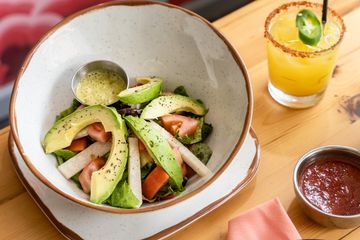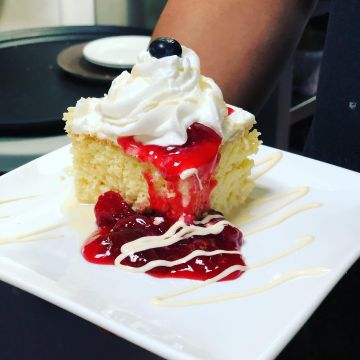Enjoy freshly made freshly made guacamole during happy hour
Wiki Article
What Are the Vital Meals That Specify Mexican Cuisine?
Mexican cuisine is a lively representation of its cultural heritage, identified by a range of vital dishes. Tacos, mole, pozole, tamales, and ceviche each inform an one-of-a-kind story of tradition and taste. These foods not only please the taste buds but additionally symbolize the spirit of area and event. Comprehending their significance discloses much about Mexico's cooking identity. What exists underneath the surface of these precious dishes?
Tacos: The Quintessential Road Food
Tacos are commonly considered as the quintessential road food of Mexico, celebrated for their versatility and rich tastes. They contain a basic tortilla, usually made from corn or flour, filled up with a variety of active ingredients that can range from grilled meats to vegetables. This flexibility enables many local variants, each showcasing neighborhood flavors and traditions.Popular fillings include carne asada, carnitas, and pollo, usually come with by fresh garnishes like cilantro, onions, and lime. Street vendors skillfully prepare and offer tacos, making them a convenient and affordable choice for visitors and residents alike.
The experience of consuming tacos is improved by the vivid atmosphere of Mexican streets, where the scent of seasonings and sizzling meat fills the air. This iconic meal not only satisfies appetite yet also represents the cultural richness of Mexico, showing its background, community, and cooking creativity.
Mole: A Harmony of Flavors
Mole embodies the complexity and depth of Mexican cuisine, supplying a rich tapestry of flavors that astound the palate. This sauce, often made with a blend of chilies, seasonings, nuts, and delicious chocolate, showcases the creativity and cultural heritage of Mexico. Each area flaunts its distinct interpretation, with variations such as mole poblano and mole , mirroring regional components and customs.The preparation of mole is an elaborate process, calling for ability and patience as the active ingredients are carefully toasted, ground, and simmered to perfection. The resulting sauce can vary from full-flavored to sweet, with layers of taste that advance with each bite. Typically served over chicken or turkey, mole goes beyond mere nutrition, frequently gracing special events and celebrations. Its vibrant shade and complicated profile signify the abundant culinary identification of Mexico, making it a crucial recipe that reverberates with both site visitors and residents alike.
Pozole: A Hearty Tradition
Frequently appreciated during cheery gatherings, pozole is a recipe deeply rooted in Mexican custom, embodying both cultural significance and communal spirit. This passionate soup, made primarily from hominy, meat-- generally pork or poultry-- and a rich broth, has ancient beginnings that map back to pre-Columbian human beings. Commonly gotten ready for celebrations such as Mexican Self-reliance Day and weddings, pozole goes beyond plain sustenance, cultivating a sense of unity amongst those who participate.The recipe comes in numerous regional variants, consisting of pozole rojo, blanco, and verde, each distinguished by its unique components and flavor profiles. Toppings such as shredded cabbage, radishes, avocado, and lime improve the meal, enabling individual expression. Past its scrumptious top qualities, pozole functions sushi ko as a symbol of heritage, linking generations via shared dishes and culinary practices. Its prep work usually becomes a common occasion, strengthening bonds among friends and family, making it a real emblem of Mexican friendliness.
Tamales: Wrapped crazy
Tamales hold an unique place in Mexican cuisine, just like pozole, celebrating practice and community. These wonderful parcels of masa, or corn dough, are generally filled up with a range of ingredients, consisting of meats, fruits, cheeses, or vegetables, and then covered in corn husks or banana leaves prior to being steamed to perfection - churros. The prep work of tamales commonly includes family celebrations, where generations integrated to share the labor of mixing, loading, and covering, reinforcing their significance as a public mealTamales are particularly preferred throughout festive celebrations, such as Xmas and Día de los Muertos, symbolizing a link to cultural heritage. They are not just food; they personify love, treatment, and the passing down of cooking abilities. Each region in Mexico boasts its very own distinct variations, showcasing local tastes and practices, making tamales a beloved staple that transcends generations and joins individuals throughout the country.
Ceviche: A Fresh Coastal Joy
Ceviche, a dynamic dish rooted in the seaside regions of Mexico, showcases the quality of the ocean's bounty. Traditionally made with raw fish marinated in citrus juices, specifically lime, ceviche is celebrated for its invigorating flavor account. The level of read the full info here acidity from the lime "cooks" the fish, leading to a tender appearance that sets wonderfully with the brilliant active ingredients typically consisted of, such as diced tomatoes, onions, cilantro, and chili peppers.
Areas like Baja The Golden State and the Yucatán Peninsula have their own unique variations, incorporating neighborhood seafood such as shrimp, octopus, or scallops. Offered chilled, ceviche is usually gone along with by tortilla chips or tostadas, enhancing its charm as a preferred appetizer or snack. This recipe not just mirrors the rich marine life of Mexico however likewise highlights the social significance of fresh, regional components in Mexican gastronomy. Ceviche remains a cherished representation of seaside cooking practices.
Regularly Asked Questions
What Are the Key Components in Traditional Mexican Cuisine?
Secret active ingredients in traditional Mexican food consist of corn, beans, avocados, tomatoes, and chilies. take out and delivery. These staples create the structure of lots of meals, reflecting the vibrant flavors and varied cooking heritage of Mexico's rich gastronomic landscapeHow Has Mexican Cuisine Developed Gradually?
Mexican food has actually progressed with centuries, affected by aboriginal practices, Spanish emigration, and global components. This vibrant mix has actually resulted in varied regional flavors, strategies, and dishes that continue to adjust and innovate with contemporary culinary fads.
What Prevail Dietary Restrictions in Mexican Food Preparation?
Typical nutritional limitations in Mexican cooking click site include vegetarianism, veganism, and gluten intolerance. Numerous typical dishes can be adjusted to suit these preferences, making sure that tastes remain dynamic while valuing individual social techniques and dietary needs.Exactly How Do Regional Variations Impact Mexican Dishes?
Regional variants substantially influence Mexican meals through regional active ingredients, conventional food preparation methods, and social influences. Each area's unique environment and background contribute distinctive flavors, techniques, and recipes, resulting in an abundant culinary variety throughout the country.What Beverages Set Best With Mexican Food?
Typical Mexican food sets well with drinks like horchata, aguas frescas, and tequila. Craft beers and mezcal additionally complement the flavors, enhancing the eating experience with their invigorating qualities and distinct profiles.Mexican cuisine is a vibrant reflection of its social heritage, identified by a selection of essential dishes. Mole embodies the intricacy and deepness of Mexican food, supplying an abundant tapestry of tastes that mesmerize the taste. Usually appreciated throughout cheery celebrations, pozole is a meal deeply rooted in Mexican custom, personifying both social value and public spirit. Mexican cuisine has developed with centuries, affected by native customs, Spanish emigration, and international active ingredients. Regional variations considerably affect Mexican meals via regional active ingredients, traditional cooking approaches, and social influences.
Report this wiki page